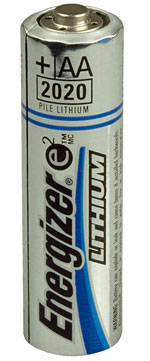
Lithium batteries consist of the following:
- A positive electrode (anode) made of lithium
- A negative electrode (cathode) made of manganese dioxide and graphite
- An electrolyte of lithium perchlorate in a mixed solvent of propylene carbonate and dimethoxyethane
Published November 2010
These are long-lasting lithium batteries (AA and AAA sizes) for powering things like clocks, toys, and cameras. Electric current is generated by chemical changes inside the battery and these occur at the anode and the cathode and involve a transfer of electrons. The chemical reaction begins when the battery becomes part of an external circuit through which the electrons can flow from one electrode to the other.
Ingredients
Lithium atoms release electrons to become positive ions (Li+), the manganese atoms gain them, going thereby from manganese(4+) to manganese(3+).
Lithium is the lightest of all metals and its compounds are also used in greases, medicine to treat bipolar depression - and hydrogen bombs.
Lithium stearate, made from the fatty acid stearic acid, is a component of most lubricant greases. It stays soft at temperatures as low as minus 60°C and is used for vehicles in the Antarctic.
The hydrogen of hydrogen bombs is the compound lithium hydride, in which the lithium is the lithium-6 isotope and the hydrogen is the hydrogen-2 isotope, also known as deuterium. Lithium hydride is capable of releasing massive amounts of energy by nuclear fusion. A chain reaction is initiated by an atomic bomb at the core of the weapon and it is the detonation of uranium-235 in that which creates the incredibly high temperatures and neutrons needed. The latter are absorbed by the lithium-6 which immediately disintegrates to form helium and hydrogen-3. The hydrogen-3 then combines with the hydrogen-2 of the lithium hydride to form yet more helium and releases even more neutrons. These are absorbed by the casing of the bomb, which is made of another uranium isotope, uranium-238, and this releases yet more energy. Within a fraction of a second there is an explosion equivalent to millions of tonnes of TNT.
Manganese dioxide (MnO2) has been used in dry-cell batteries from the earliest days. There is a naturally occurring mineral, pyrolusite, which is MnO2 and mined on a large scale. It needs to be processed to remove impurities before being incorporated into batteries. Manganese dioxide is the black pigment of prehistoric cave paintings.
The electrolyte is the salt lithium perchlorate (LiClO4) dissolved in a solvent and which provides a conducting medium between the anode and cathode.
The solvent has to dissolve charged ions, in this case Li+ and ClO4-, but the usual solvent for these, water, cannot be used because this would react violently with the lithium metal. The liquid propylene carbonate (aka PC, C4H6O3) can also dissolve ions but this is very viscous liquid so it is diluted with dimethoxyethane (C4H10O2). Both these liquids find other uses: propylene carbonate is an ideal base for makeup, mascara and even lipstick, while dimethoxyethane is used as a solvent for paints, pesticides, and air fresheners.